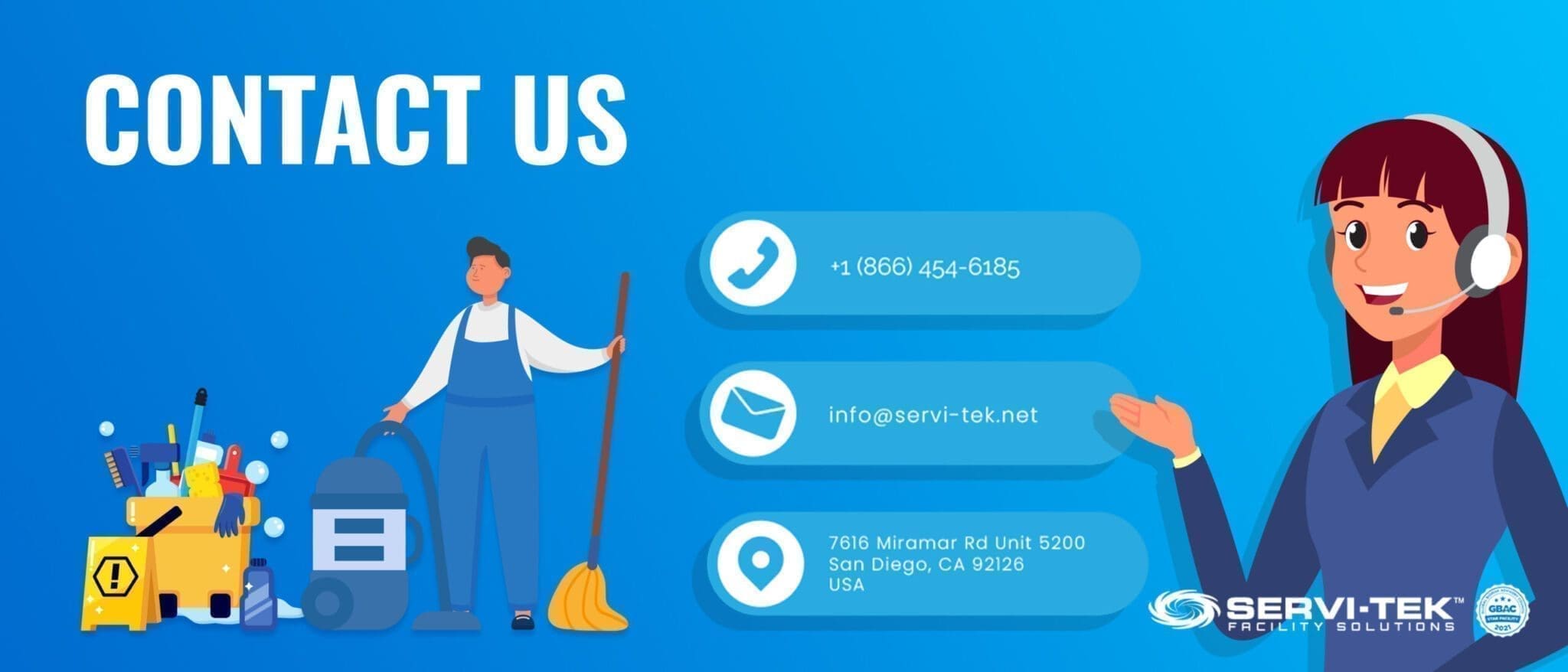Residents of long-term care facilities thrive in clean, safe, comfortable, and healthy surroundings. Healthy working and living spaces result in high visitor, staff, and resident satisfaction. It is important for facility managers to know what should be included in cleaning and disinfection services to ensure the safety and protection of their residents, visitors, and staff.
This post will help you understand the right way of cleaning and disinfecting a long-term care facility and the various factors to consider while establishing protocols.
KNOW THE DIFFERENCE BETWEEN CLEANING VS. DISINFECTING
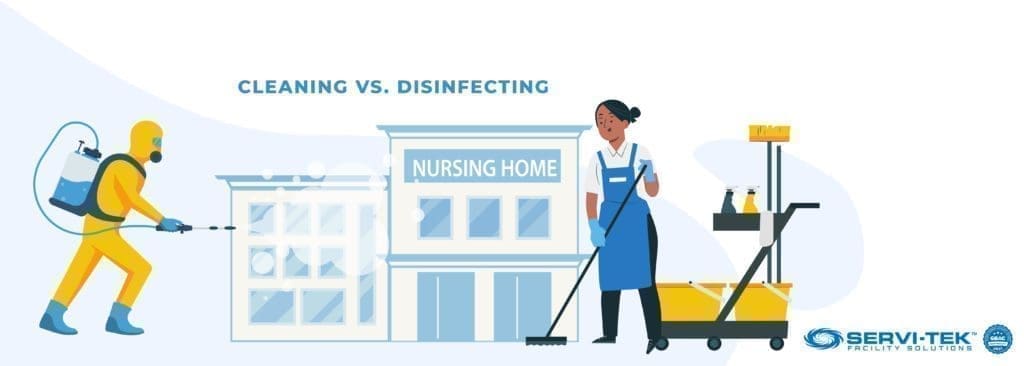
The difference between cleaning and disinfecting is not always completely understood by cleaners. You should ensure that your cleaners, whether commercial or in-house are aware of the difference. Cleaning basically involves removing soil from a surface. Salmonella, E. Coli, Influenza, and Difficile infection are real risks and are considered primary healthcare-associated infections. Disinfection will help in killing the germs that cause these.
It is vital that all high-touch surfaces be disinfected daily in healthcare facilities. You may want to instruct your team to wipe down these surfaces with disinfectant wipes or towels multiple times a day. This is particularly necessary for common areas where the residents of your LTC facility gather.
Cleaning is necessary for proper disinfection. Disinfecting agents can work only when the surface is wiped down and free from dirt and debris. There are certain innovative cleaning methods in which cleaning and disinfection can be achieved in a single step. You would require the right type of multipurpose cleaning product.
In any case, multipurpose products are useful as they allow cleaning of a wide array of soils and surfaces. You should look for hospital-grade disinfectants and multipurpose cleaning products listed on EPA List N. These are specially formulated to remove a broad range of germs from the surface and will ensure that everyone in your long-term care facility remains safe.
Right products are effective, and efficient and ensure the job is done right. It can also save money by reducing labor time.
Six Stages of Cleaning in LTC Facility
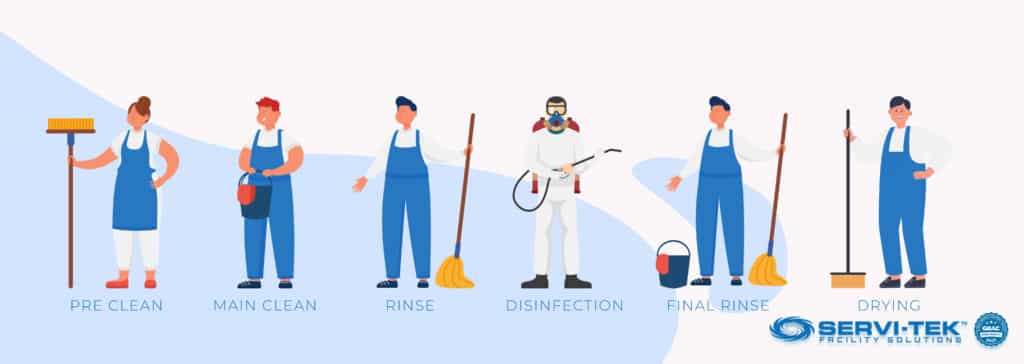
You need to follow an effective cleaning procedure if you want to avoid health and safety risks. Cleaning and disinfection when done right can completely remove 99.999% of microorganisms. You can focus on key aspects of effective cleaning with each of these 6 stages of cleaning.
These are the six stages of cleaning:
1. Pre-Clean
The first step in any housekeeping process is to remove loose substances and debris from the contaminated surface. This step generally involves rinsing, sweeping, and mopping. The primary aim of this step is to remove as much debris as possible. This is important for preparing the area for the next step of cleaning. This step is vital when cleaning resident rooms and common areas. You should pay special attention to carpet vacuuming.
2. Main Clean
The second step of cleaning is to loosen dirt, substances, debris, and grease. These are substances that you may not have been able to remove during the pre-clean step. Main cleaning involves using detergent and hot water. Cloth or mop is used for wiping away loosened substances. Certain cleaning solutions need to be left on the surface for a longer period of time for them to be effective.
3. Rinse
The third step for effective cleaning is to remove loosened dirt, substances, and debris. You should remove the detergent in this step as well. Rinsing is best done with hot water and a clean mop or cloth. However, water cannot be used on all types of surfaces. You should train your employees on best practices.
4. Disinfection
Disinfecting a surface is an important step in the cleaning process. You need to take the right measures for destroying bacteria and other germs. Electrostatic cleaning systems are generally recommended for long-term care facilities. Take care to leave the chemical disinfectant on the surface for an adequate amount of contact time.
5. Final rinse
This step entails removing the disinfectants from the previous step. Hot, clean water is again recommended for this. However, you should pay attention to the manufacturer’s recommendations and the type of surface being cleaned. It is best to retain the services of a commercial contractor for ensuring your senior living facility is kept germ free.
6. Drying
The final stage of cleaning is to dry the surface. You won’t need to worry about this step if you use an electrostatic sprayer. Drying clothes can be used if necessary. However, these should be single-use. Mops, rags, and clothes from one room should not be taken to another resident’s room in your long-term care facility. This poses a contamination risk.
These six steps of cleaning and disinfection will ensure that all surfaces and areas in your long-term care facility are aesthetically clean and free of germs.
Create Protocols and Checklists for Cleaning
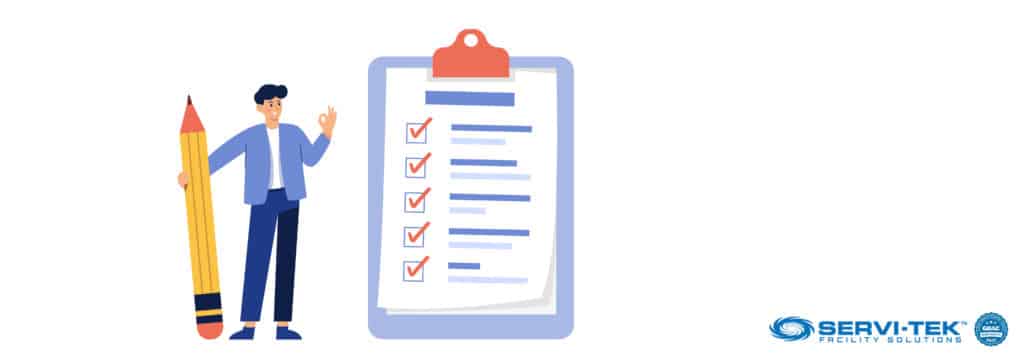
Cleaning is essential in a long-term care facility. You should educate your staff on the right protocols for cleaning and disinfection. Make sure they are trained on how to clean correctly. You may want to create a checklist accounting for high-touch areas in the facility. This includes sink faucets, tables, chairs, drawer pull handles, and doorknobs.
This will ensure the places are properly and consistently cleaned and disinfected. A checklist inspection sheet will ensure that all cleaning tasks are completed every time. Checklists are beneficial to cleaners since they remain aware of what to expect.
You should remember that workers will not do what you expect, but what you inspect. You should try to have a system in place for confirming that your cleaning needs are always met. The disinfectant solution needs to be left on surfaces for the intended period whether you use a stand-alone or a multipurpose product. Cleaning professionals must avoid wiping and spraying. The cleaning crew should carefully read and follow label instructions. Cleaning products are effective only when they are used as intended.
Cross-contamination can be prevented by effective cleaning and sanitizing. UV light bars are increasingly being used for sterilization. These can be used as an add-on to existing cleaning routines. However, UV lights should not be used in place of proper cleaning. Further, cleaning tools, such as brushes, scouring pads, scrapers, and mops can be potential sources of cross-contamination.
There should be specific procedures in place for properly and regularly cleaning and sanitizing tools. It is important to remember to thoroughly disinfect high-touch areas to prevent the spread of germs.
Pay Special Attention to Washrooms
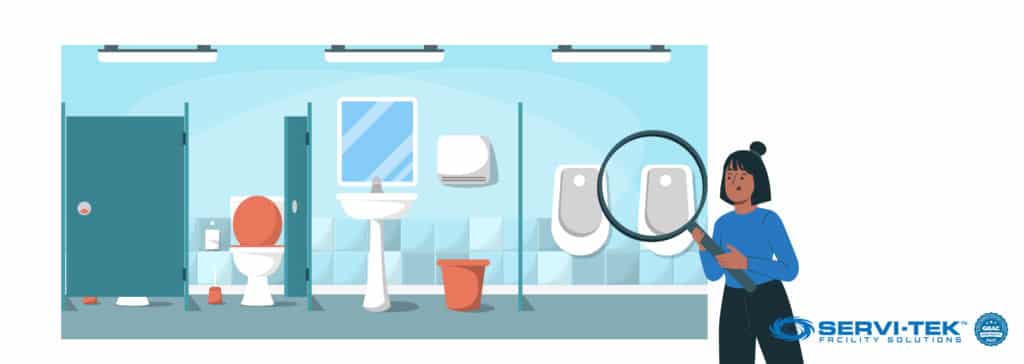
Restrooms harbor different types of germs. It is vital that you clean them correctly and regularly for maintaining an odor-free and clean appearance. There are a dozen or more tough-to-clean areas in a restroom, such as toilet seats, door handles, sinks, urinals, faucets, counters, flushing levers, soap and paper dispensers, partitions, and more.
Cleaning professionals should not ignore the source of smells in washrooms. It is essential that they do not mask the smell with scented products. You need to invest time to maintain efficiency and consistency. The eventual dividends of a formal training program are usually significant. Bathrooms and toilets are a primary hub of pathogens. A moist and humid environment makes it easier for bacteria, viruses, and other pathogens to breed.
Properly trained employees take pride in improving environments using correct disinfection and cleaning techniques. The staff should be educated on the proper procedures, tools, equipment, and cleaning solutions to use for a germ-free environment. Special attention should be paid to communal toilets. These need to be cleaned multiple times a day. Facility managers should make use of EPA-registered multipurpose cleaning products for simplifying cleaning and ensuring a safe and germ-free environment.
Never forget that cleaning and wiping down surfaces to remove debris is a must before you disinfect any surface. In fact, you may want to consider using electrostatic spraying techniques. This has been proven useful for washrooms as well. High-touch areas, such as door knobs, faucets, shower heads, counters, toilet handles, door handles, and other things should be addressed multiple times a day.
Healthcare facilities in the United States may have come ahead of Covid-19 but it not yet beat completely. Taking precautions can help ensure that your residents are safe. Other critical points to take care of include light switches, washer, and dryer buttons, and toilet seats. Adequate attention should be paid to both hard and soft surfaces.
Preventing Infection in a Long-Term Care Facility With Efficient Cleaning Methods
Nearly two-thirds of all norovirus outbreaks, as per a study conducted by the CDC, are reported to occur in long-term care facilities. Low temperatures during winter allow an increasing number of pathogens to spread. This causes people living in close proximity to spread infections among each other. More precautions need to be adopted to prevent outbreaks. The right cleaning and disinfection protocol is the first step.
Your staff should regularly disinfect areas and surfaces as per the guidelines laid down by the Environmental Protection Agency (EPA). You should keep an eye on the product label to identify whether it is for bacteria, viruses, or multiple pathogens. Frequent hand washing among staff members is another great way of fighting infection. This habit should be encouraged among residents as well.
Garments, towels, and linens are potential hubs of germs. Soiled laundry should be quickly tied in linen bags. Highly effective detergents from reputable brands should be used to wash linen and garments separately. It is ideal if the bedding and garments of different patients are not mixed. Seniors have delicate skin. Using harsh chemicals in a bid to control illnesses and diseases may cause irritation.
Industrial-grade chemicals may result in respiratory tract infections in acute patients. Higher severity of illnesses is possible when wrong cleaning solutions or an incorrect amount is used. Cleaning professionals should follow the guidelines laid down by the Centers for Disease Control and Prevention (CDC). This is particularly necessary for preventing the spread of key viral infections of concern, such as the coronavirus and norovirus.
The following tips are recommended for making a long-term assisted facility germ-free. These tips were adapted from the Infection Preventionist’s Guide to Long-Term Care published by the Association for Professionals in Infection Control and Epidemiology:
Develop a plan: An infection control and prevention plan should be developed for the facility that includes consistent disinfection and cleaning schedules. The plan should also outline staff responsibilities in a clear manner.
Use the right cleaning protocol: You should always work from the cleanest to the most soiled when cleaning. In reality, in-house cleaning teams tend to focus on dirtier areas first. This increases the risk of cross-contamination. An innocent mistake, such as using the same rag may spread infection-causing pathogens across the facility.
Daily disinfection: High-touch surfaces should be cleaned and disinfected on a regular basis. This will protect the staff, residents, and visitors at the retirement home. In fact, ensuring a safe space for workers is an OSHA guideline. You can significantly reduce risk factors with daily disinfection using these simple tips.
Follow label instructions: You cannot create a healthy environment for your residents if you don’t allow the chemical to remain on different surfaces. Dwell time is to ensure the highest standards of cleanliness and to prevent the spread of infectious diseases.
- Surface care: It is not enough for a cleaning crew to keep a space organized and aesthetically pleasing. They need to go deep and ensure a safe environment for the residents, staff, and visitors. The cleaning team should be trained on using the right cleaning products for maintaining fixtures, furnishings, and floor care
Experienced cleaning contractors servicing long-term care facilities pay attention to infection control, floor care, resident health, and more.
Speak With a Trusted Commercial Cleaner for Your LTC Facility
It takes the right cleaning equipment, tools, chemicals, and protocols to ensure a long-term care facility is not affected by any disease-causing pathogens. The team at Servi-Tek has years of experience in cleaning assisted living facilities, nursing homes, senior centers, and retirement homes. We have a deep understanding of your requirements and will work with you to create a cleaning and disinfection plan that best suits your needs and purposes.
Schedule an appointment today by calling (866) 454-6185 or using our online form.



